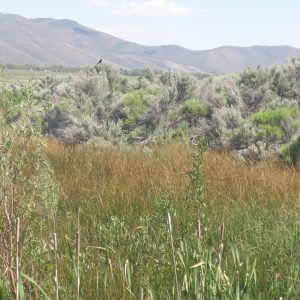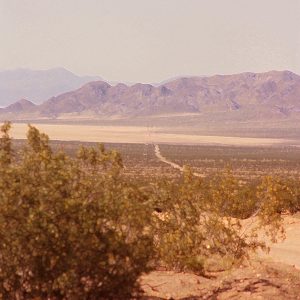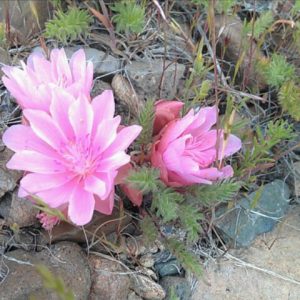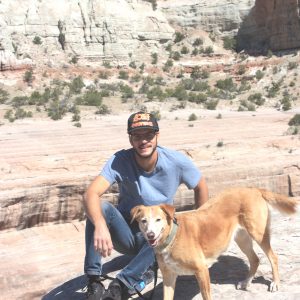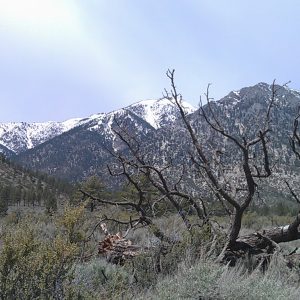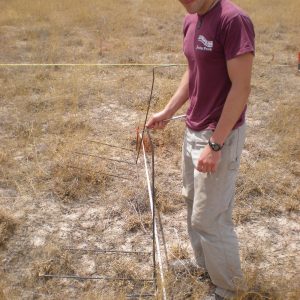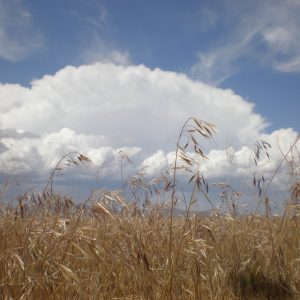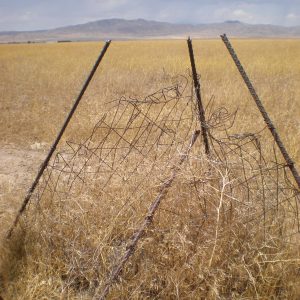In addition to my botany work at the Bureau of Land Management, this month I had the opportunity to participate in a study conducted by another federal agency, the USGS. The study aims to determine the effects of various vegetation treatments on sage grouse habitat, and to identify any benefits of different treatments for sage grouse. During my two weeks camping in the field, I acquired valuable experience conducting vegetation point transect surveys as well as subplot vegetation sampling to determine species composition, cover and abundance. My time with the USGS has been great for many reasons. Working with a knowledgeable and experienced field crew has increased my field skills, I learned more about the flora of the region, and I met great people!
Daily Archives: 25 July, 2011
A Different Perspective
I traveled over 3,000 miles to get to Carson City, Nevada. Once here, I found out the surrounding lands were very different from what I originally imagined it would be like.
This internship proved to provide me with multiple opportunities to expand and grow though my experiences. The Drive across the nation was one of the most amazing journeys I took. I drove out with my two best friends Doug and Lady, the dog I rescued in high school. All of us were on a limited budget, we had with no reservations and only vague ideas of national parks and general destinations we wanted to camp at and visit. I felt a little like Kerouac embarking on the ultimate adventure, a right of passage almost.
Since I began my internship I’ve met great people and have been able to participate in various projects. Our team of nine interns accomplished a great task of planting 21,000 Bitterbrush seedlings as a fire restoration project. Although the work was challenging we made each day entertaining and unique. While we were busy helping establish the bitterbrush seedlings into their new homes I was able to begin to become introduced to the plants of the west. I became familiar with the landscape and as time went on and we took on monitoring, and conservation projects I found myself adjusting to life out west.
I still have a lot to learn so off I am on another busy work week in Carson City, Nevada.
Desertification
July 8, 2011
Las Cruces, N.M.
The sun beats incessantly
To a soundless drum
Today is the end of my third week as a CBG intern. Stationed in southern New Mexico, I have been told that this is one the driest years on record for the area. The springs rains failed to show up, and the landscape is brown and crispy all around. This is reflected in the numerous record sized fires that continue to burn throughout the southwest. The skies here are often hazy with smoke, and gusts of powerful winds are not uncommon. We are all hoping for the monsoon season to get here soon, otherwise it is questionable how successful the seeds around here will be.
Yet despite the drought, life still persists in this harsh land. The large majority of the plants here I had never met before, and it is exciting to learn about a completely different flora. Ocotillo, mesquite, creosote, cholla, prickly pear, yucca, acacia, and sotol are just a few of these new plants. But one cannot forget the Agaves. I was fortunate enough to see a few of these in full bloom yesterday at the Little Hatchet Mountains. These striking plants spend 8-20 years in a strictly vegetative state, but when the stars align and the time is right they will send up a single stalk (can reach over 13 ft!) of flowers before dying. In honor of their patience I urge you to sip your next tequila slowly, pondering such a life strategy.
Like many other interns my main job here is to collect seeds. So far we have made a collection of, after much debate, Populus deltoides along the Tularosa river. Cottonwoods, I’ve found out, are quite confusing in this area and ideally one has a collection of multiple developmental stages of the tree in order to make a confident identification. No matter the species, though, they provide welcome shade for a day in the field. I look forward to making more seed collections, and to begin working with the other CBG intern next week.
East meets West
Coming from the East Coast, it’s interesting to think about the idea of “land management.” The concept seems broad, encompassing a whole range of activities under one blanket term. Are we protecting wildlife (or wild life, to use that simple but significant difference in the term)? Do we see the work as resource preservation or resource conservation? Or something else?
I just spent the last few days with the Cedar City BLM range crew, mainly to familiarize myself with the vegetation, though we barely scratched the surface. The surprising part was that I had never been exposed to “range” work before, especially as a field of study. The range crew told me that we were surveying the BLM grazing allotments for vegetation species and abundance. This was my first surprise. In the East, land seems to be categorized quite specifically for its use. But here we were, out on one small plot of the millions of acres of BLM land to see how the land is suited for grazing. Meanwhile, some of my other seasonal counterparts were out surveying the vegetation in other areas to see if it was adequate habitat for sage grouse.
On the first day, we visited a site that one of the range crew workers said “we should’ve surveyed by satellite;” it was parched and primarily filled with cheatgrass. Even the range cage, set up to protect a small plot of vegetation from grazing animals to see what grows in their absence was crumpled and full of taller cheatgrass. Biologists and rangeland managers alike would see it as problematic, and we joked about how a squatter could find a home there and never be bothered about it. Through my eyes, born and bred in the eastern U.S. and used to seeing an obvious purpose, plan, direction, or advantage in the state of the land, I was struggling to see this land’s place in the BLM’s grand scheme. With all the millions of acres, how do we look at this one site and see its potential for sustaining livestock with diverse vegetation for years to come?
Keep in mind, I understand the importance of this work. I see that this public land is in high demand for multiple uses and that our branch of the government spreads its resources thin over a diversity of projects with lofty goals. My simple point in these observations is that I am looking at a new landscape through alien eyes. I’m excited to spend these five months learning not only how land management works on the ground, but also how to look at the landscape and see all of its potential. I heard a long time ago that landscape conservation is all about seeing what could be and wrestling to make it happen. If I see an endless field of cheatgrass and a bludgeoned range cage, I want to see how it could become an ideal landscape. I want to see how our influence can take effect for the better.
Fun with Phacelia
I can’t believe it’s time to post to the blog again, because that means I’ve been at my internship for over a month now. Time flies when you’re having fun!
Last week was the training workshop at the Chicago Botanic Garden. I finally got to meet Krissa and Marian, who are totally awesome. I also got to hang out with all the other interns in the program, which was like being back in college, except where everyone else loves plants as much as I do. The Chicago Botanic Garden was beautiful. I learned some really interesting things, and we had a ton of fun going into the city Friday night. Basically the workshop was awesome, although the humidity definitely made me appreciate working in the desert.
As for life back in Grand Junction, my most recent excitement was finding a rare threatened plant, the DeBeque phacelia. It’s a tiny annual forb that only grows in a very specific environment, in bare loose soil on southwest or east-facing slopes. I have never been so excited over a tiny dried-out plant.
In other news, I went wine tasting in Palisade last weekend, which is cool since I never would have thought of wineries in Colorado. They actually have some international award-winning wines. Best part was the tasting was all free!
Also I’m covered in bug bites, especially on my feet. Just thought you all should know.
Botanic Garden
What a great week to write my blog post! I just got back from the Conservation and Land Management Internship Training held in Chicago. This week-long orientation/training was filled with learning new information, meeting new people, and seeing new sights. The workshop was held in the Chicago Botanic Garden, which is absolutely gorgeous. Such a variety of plants can be viewed in these 385 acres and I was fortunate to see most of them.
Connecting with the other interns in the program throughout the week was invaluable. I enjoyed listening to their stories and seeing the differences in our jobs, but more importantly the similarities. Being able to see that I was linked to an entire community of individuals spread across the country showed me the importance of this project.
Having the gardens as the backdrop for the week was incredible. I was like a kid in a candy store every time I had a spare moment to go explore the grounds. My all time favorite plant from the gardens was an Allium, pictured below. Their flowers reminded me of a Dr. Seuss Book and how unique each living thing can truly be.
Only 4 months left of my Internship here in Farmington, NM and I am astonished at how quickly time is moving. I had a great time in Chicago and am now looking forward to getting back and gathering more seed collections for the Seeds of Success Program.
Back to Real Life at the Bend Seed Extractory!
Back from CLM intern training at the Chicago Botanic Garden and I’m having to re-adjust to my regular life. The gauntlet of botany, monitoring, protocol and safety information we got was intense for sure. Most of it was great for refreshing all that information that I’ve lost in the three years since finishing school. Meeting the new crop of interns was awesome and tromping around the city and the burbs was a great way to relax after long days of filling my head with information. The setting for the training wasn’t too shabby either.
So, now I’m back in Bend picking up where I left off, cleaning and packaging endless mountains of seed from the 2010 field season. (Nita keeps telling us that we’re actually making great progress and 2010 will be done before we know it.)
I can’t believe it – This week marks my one year anniversary at the Bend Seed Extractory!
So what have I learned and how have I grown? I could say that I’ve learned about hundreds of native plant species that are commonly used in ecological restoration all over the western US, which is true… I could say that I am better equipped to understand the need for native seed availability and what it takes to provide viable native plant material to a quickly growing market, which is also true… But…
Without a doubt the biggest way that I have grown this last year is through observing and interacting with the people that I’ve worked with. In this last year I’ve seen one manager retire, a supervisor move into that managers role, learned to co-exist with the most difficult co-worker I’ve ever come across, and had to train a hand full of new employees with a huge range of ages, experience levels and personalities. I’ve spent lots of time observing people interact. Tense social and professional situations happen frequently here as I’m sure they do in most professional settings. I’ve been asking myself how I might handle them if it was my responsibility and what the possible outcomes could be. This year I’ve gained a confidence in myself that I know is going to push me to places I might never have considered before coming to work at the Bend Seed Extractory. Thanks CLM!
The Far North
The journey begins. I, Emily Capelin, am finishing my third week in Anchorage, Alaska working with the BLM as well as the Alaska Natural Heritage Center through the University of Alaska Anchorage. Our mission is collecting seeds for restoration of lands damaged by fire, mines, and oil and gas pipeline construction. These past three weeks have been spent in preparation for the grand adventures to come. We’ve been in the office applying for collection permits and calling other regional BLM offices about using their research facilities. We’re planning trips all over the state for seed collection. And, best of all, we’ve been traipsing through the wilds of Alaska scouting around in plant communities, looking at progress of seeds and locations of certain plant species whose seeds we want to collect later.

My mentor Mike Duffy, on the left, and botanists from the Plant Materials Center in Alaska. We're on top of The Butte in the Matanuska River Valley, looking for a rare Pasqueflower.

Mike Duffy and a botanist friend looking for plants in the Matanuska Valley. Pioneer Peak looms in the background. We found lots of Chamerion angustifolium, Cerastium, Artemisia frigida, and Oxytropis.
We have made our first seed collection this week, gathering some 9 thousand seeds of Viola adunca, a beautiful deep purple violet. Exciting to have and hold something solid! I’ve been lucky, to spend the long days of the Alaskan summer (right now, we have about 19 hours of daylight!) amongst flowers and vast landscapes. My famed Botanist mentor Mike Duffy and I have been hiking along a glacial river bar looking for a rare species of native Clematis. We’ve walked through immense fields of Lupinus nootkatensis (Nootka Lupine) beneath the high peaks of the Chugach Mountains, and climbed a small mountain in search of Artemisia frigida and an elusive Pasqueflower. And I’ve seen Brown Bears and a river otter! All for the mighty purpose of establishing seed banks that provide anyone with the means of revegatating damaged lands with native seeds. A worthy goal. I am honored and elated to be a part of the project.
Monsoon Season!
We had the first rains of the “monsoon season” last week! I haven’t seen rain in two months so it was a very pleasant sight! The rain has brought an abundance of reptiles. Hopefully I will get to see a Gila Monster before the summer is over!
My knowledge of Arizona plants is expanding! I recognize several more plants than I did a month ago and I’m even starting to remember their Latin names! The past few weeks we have been scouting for Sporobolus airoides, Sporobolus wrightii, Muhlenbergia porteri, Bouteloua eriopoda, and Bouteloua gracilis. Hopefully with more rain things will start greening up and we will have an awesome collecting season.
We have also been working in the herbarium at the BLM office. The plants specimens are gorgeous! I’m still trying to figure out how to press a cactus without getting a million spines in my fingers! I guess it just takes practice!
Arizona
The rains are here in the desert which is a welcome sight for someone who is from the Midwest. You can tell when it is going to rain because the creosote bushes begin to smell good. Hopefully with the rain the grasses that are on our target list will begin to grow, and we might actually get to collect seeds. But for now we have been scouting out different areas such as Araviapa Canyon, Turkey Creek, Bonitia Creek, and Sandraw to name a few. Being here is a great opportunity to learn new plant species, and make some new friends. The transition from riparian areas to desert is abrupt to say the least, especially in the canyons. But if you go higher up in elevation it should come as no surprise that the plant communities change. Looking out across the landscape one can see the different patches of plant communities.
All we can do for now is just wait for more rain, because with rain comes seeds. But there are some amazing plant communities and species out here. To name a few: Schott’s yucca, Parry’s Agave, Devils claw and many others. I can’t imagine what it was like for the first people to do plant inventories out here, but I hope that they were just as awe inspired as I am now.

